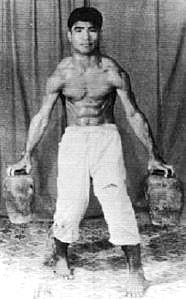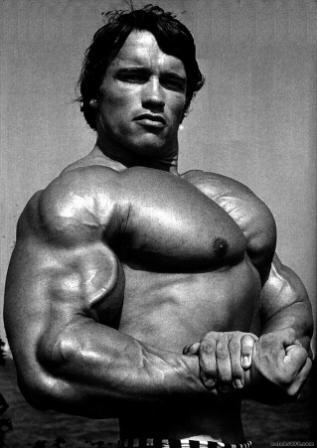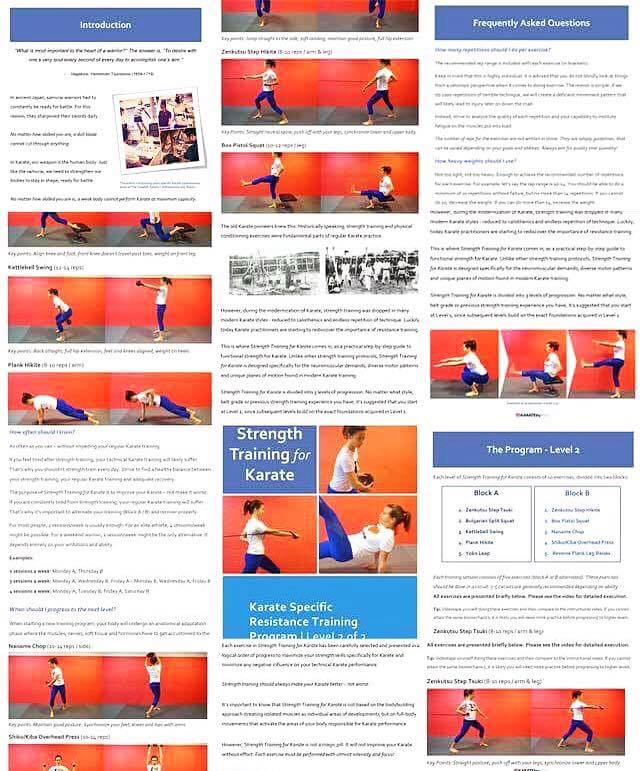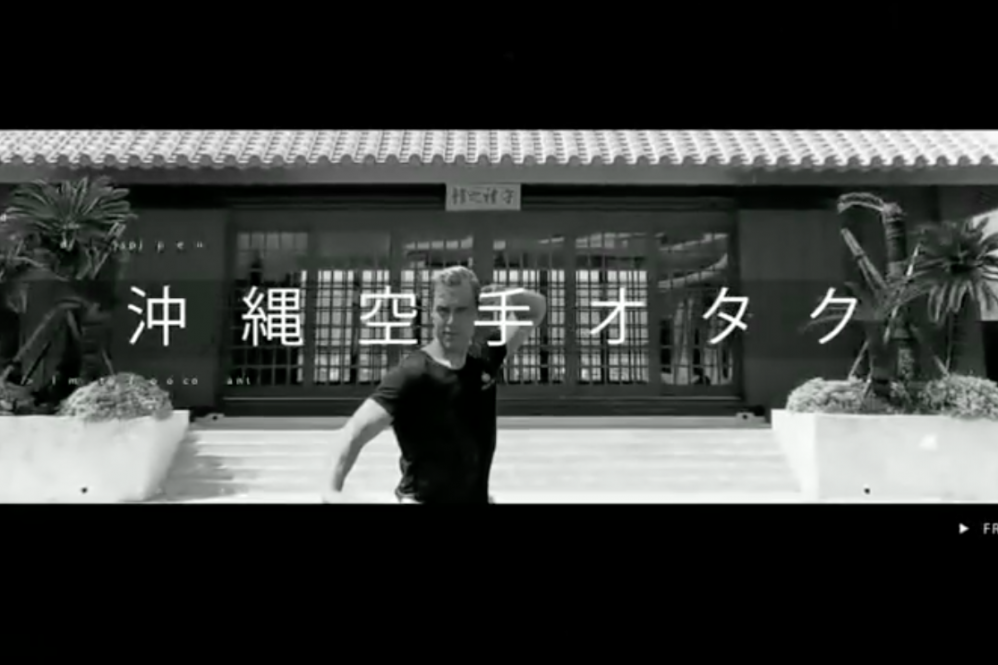“Lifting weights makes your Karate bad.”
Wrong.
Physical training is essential for Karate.
A weak body cannot sustain high-level Karate practice for long.

But it has to be done right!
For example, you should NOT follow a standard bodybuilding program.
Studies show that a bodybuilding program decreases your activation of motor units (making your Karate techniques worse) and only gives a minimal boost in speed-strength (the ability of your neuromuscular system to produce the greatest possible impulse in the shortest possible time).
So…
Forget Arnold Schwarzenegger.
Think Bruce Lee!
You need functional strength that improves your Karate performance.
Therefore, I invited my friend Vilhjálmur Halldórsson, a graduate of the most prestigeous physical education program in Iceland, to share his expertise with you.
In this article you will learn exactly how to construct your own physical training program for Karate.
But wait!
If you DON’T want to create your own program, click here to download Strength Training for Karate instead – my ready-made program for you.
Now…
Let’s start the free guide:
Why Strength & Cardio Training?
First of all, the basics.
I often have a hard time convincing Karate-ka that they should lift weights.
Typically, this resistance stems from bad experience with prior strength training (i.e. feeling heavy, slow gains, getting injured etc.). I don’t blame these people, because often they’ve been doing a “body-split routine”, which is not good for Karate.
Body-split routine means that in each session you’re working only one bodypart.
Like Arnold.
For example; on Mondays you work chest (Mondays are international chest day) and on Tuesdays you do the back. This allows you to put a great amount of training volume on specific bodyparts.
That’s great – if you’re getting ready for the beach!
The rest of us wants to strength and cardio to enhance our Karate skills.
In Karate, we are always trying to use our body the most efficient way. Thus, we should pick exercises that challenge the entire body as a unit, based on the true concept of Karate.
This allows us to maximize our power for Karate.
But physical training is more than lifting weights. It’s about optimizing your performance for any activity.
Therefore, a personal trainer will look at how you run, squat, jump, push, pull and twist to find weaknesses in these basic human movements, and then prescribe specific exercises aimed at overcoming imbalances and dysfunctions in your body.
However, most of us don’t have access to a personal trainer.
So let’s dig deeper…
The 3 Planes of Motion
Your body can move through three different planes of motion:
- Sagittal (moving forward and backwards)
- Frontal (from side to side)
- Transverse (rotational movements)
Why is it important to know these?
For example, in activities where we move excessively in the sagittal plane, and are constantly trying to create power forwards, stability in the frontal plane (sideways) is extremely important.
If you watch Karate-ka do techniques in the sagittal plane (i.e. stepping punch), you’ll often see their hip falling out as a consequence of weak hip abductors.
This is a common problem!
Whenever you step forward in a zenkutsu-dachi, you need to stabilize the front knee in the frontal plane (to the sides). But if you’re weak in this plane, your muscles can’t provide enough stabilization and this will lead to knee injury, most likely ACL injury.
So, it’s vital to know the planes of motion.
Now let’s look at how to maximize gains…
Periodization Theory
In several sports, there are seasons that dictate how an athlete trains.
The seasons are typically divided into various periods, i.e. competition period, pre-competition period, off-season etc.
Here’s a basic example for somebody who competes in Karate:
- Pre-competitive period: In this phase the Karate-ka typically works on fundamental strength, endurance, lots of technique and basics. This is known as the GPP (General Preparation Phase)
- Competitive period: In this period the Karate-ka tries to make his/her training reflect the competitive environment, with less focus on quantity and more focus on quality. Mental training and recovery plays a bigger role. This is the culmination of what’s known as the SPP (Specific/Special Preparation Phase)
- Off-season: Lastly, after your goal has been reached, a common mistake (typically in young Karate-ka) is to take a complete break from training. It is, however, much better to spend this time working against muscular imbalances, rehab and stability. Training can take a less serious tone, but a general level of fitness should be maintained. This is commonly known as the CBP (Chill on the Beach Phase) for most people. Piña Colada not included.
In Karate we don’t have the same “seasons” as regular sports though.
The lack of these defined seasons makes our periodization plan difficult. We must constantly train speed, flexibility, conditioning and strength throughout the year.
Therefore, try to always incorporate strength, speed, mobility, flexibility, stability etc. in your weekly regimen and vary the emphasis depending on how close to certain goals you are.
Try to also surprise your body with different exercises during the periodization process, and focus on improving your weaknesses in order to not burn out.
Next, exercise selection…
What Exercises Should I Do?
When it comes to exercises, you need to know that your body doesn’t care about “muscle groups”.
It thinks in terms of “movement patterns”.
Therefore, your training program should be a) primarily based on functional movements and b) involve core demanding full-body exercises.

Below is a list of suitable exercises for creating your own program.
In the list there are many exercises that can be performed on one leg or two legs.
If you do the single-leg variation you have to stabilize the movement more, which takes focus away from the prime movers. Meaning, you can’t handle as much weight but you’ll greatly improve your “functional” strength and stability. When you are on two legs it’s the opposite; you are more stable so you can use more weights, but you won’t develop the same stability.
(Which one should you choose? It depends on your skill level and goals. If your idea of fun is not being able to sit without pain for a few days, I suggest combining them both.)
Hip dominant
- Hip thrust (single/double leg)
- Stiff legged deadlift (single/double leg)
- Deadlift
- Leg curl on a Swiss ball (single/double leg)
Knee dominant
Vertical pulling
Horizontal pulling
Vertical pushing
Horizontal pushing
- Weighted pushup (or regular)
- Dumbbell incline bench press
- Bench press (wide / close-grip)
Anti-extension (core)
- Plank (with variations)
- Ab wheel rollout
- Body saw
Anti-rotation / anti-lateral (core)
Mix exercises from each category to create your own program!
Keep in mind that some of these exercises require extra instruction and preferably a spotter before your form is good enough to perform it on your own (i.e. back squat, deadlift, barbell row, bench press etc.).
All exercises can be made more or less difficult with single/double legs & arms.
It’s worth mentioning that everyone is different and you might have a muscular imbalance that prevents you from doing some of these exercises above.
Now let’s talk cardio…
Cardio Training for Karate
The human body is brilliant.
It constantly adapts to the stress that we put it under.
If you train your endurance by lifting light weights for fifty reps, you are going to get good at that. Or if you run slowly for a long time, you are going to get good at that.
People call the above “endurance training”, but neither of those options are very appealing for someone who wants to improve their Karate endurance.
The best advice for someone who wants to improve their conditioning for Karate is:
Do more Karate!
That being said, if you feel that your Karate training is not building your endurance I suggest Tactical Metabolic Training (TMT).
TMT simply means that you emulate the metabolic demands of the sport/activity you’re performing – through tweaking the various parameters of work (timing, movements, tools, intensity, frequency etc.) corresponding to your chosen activity.
For instance, a Karate athlete who competes in kumite should have the ability to go all out for three minutes, then recover, and then go again. Hence, their endurance training needs to reflect this.
For somebody who wants efficient all-round conditioning, I recommend high intensity interval training (HIIT), which has been scientifically proven to improve cardio and endurance greatly. A good example is the Tabata protocol, where you perform 8 sets of 20 sec work with 10 sec rest between, for a total of 4 grueling minutes.
Obviously the work/rest periods and types of exercises can be adjusted to better reflect your specific goals in training.
The final point I want to make here is that there’s a trend in the fitness industry that goes, “if you leave the gym still able to walk, without throwing up five times, you have wasted your time, bro!”
Bullsh*t.
If you think of training as medicine that is supposed to improve your health and well-being, does it make sense to constantly leave the gym feeling miserable?
Of course not…
Martin Rooney, a world-famous strength coach I admire greatly, once told me, “Anyone can make somebody tired, but not anyone can make somebody better”.
Train smarter – not just harder.
Now, time for 6-pack stuff:
Core Training
Anyone who has ever been to the gym has an opinion on this subject, and it’s becoming one of the most talked-about topics in the professional strength community.
I’m talkin’ core training.

Now listen…
People say things like “use your inner core” or “this is a great exercises for your lower abdominals“, without fully comprehending what they’re actually talking about.
Point being, your inner core consists of many things; including the diaphragm, transversus abdominis, multifidus and the pelvic floor – and your “lower abs” are quite often really your obliques.
Also, there’s a difference between core strength and core stability:
Core strength is the ability to move your trunk powerfully, while core stability is the ability to maintain and resist outside force – whether that force is a barbell or your own hand waving around.
An exercise where you perform a movement that directly challenges your core develops your core strength, while an exercise where there is a challenge not to move your trunk develops your core stability.
The core is important in all exercises.
This is why personal trainers don’t let their clients perform heavy lifts like deadlifts or squats if they have a weak core, since the primary function of your core is to stabilize the spine and keep it safe.
Make sure you always activate your core!

Another function of the core – especially in Karate – is to transmit energy.
If we use the example of the stationary gyaku-zuki (reverse punch) twisting your hips from hanmi to shomen (half facing to facing) you will realize that with a weak core the energy will get lost along the way, and you will have an inefficient technique.
This is why Karate-ka should strive to train rotation – because it’s one of the main components when executing techniques.
Note: My program Strength Training for Karate contains detailed video instructions of specific rotational core exercises for Karate.
However, it’s important to make sure that you rotate your hips along with the torso (keeping your back straight), otherwise you twist your lumbar spine – which is a quick way to get injured.
Lastly…
Some people will tell you that if you squat, benchpress or deadlift, you don’t need to strengthen your core specifically.
This is true if your core is firing in perfect sequence and you have good balance in all your core muscles.
But, I’ve seen really top-class athletes with inactive obliques, weak technique or a bad firing sequence (referring to the order in which the core muscles activate to hold the spine stable), so this isn’t always the case.
So train your core, bro!
Simple rules for core training:
- Do not twist and bend your lumbar spine at the same time.
- When you train rotation, make sure you rotate your hips as well.
- Make sure you train anti-extension, anti-rotation and anti-lateral flexion to have balance. Too many people just focus on anti-extension.
- Stop doing crunches. You’re most likely just training your hip flexors.
- When you can perform a one-minute plank for several sets, move on.
- Save the core exercises for last. This is for your own safety. If you have an exhausted core, you could get injured when doing heavy lifts.
- Did I mention “stop doing crunches”?
- If you don’t like core exercises, pick other exercises that are core demanding – preferably unilateral (one arm/leg).
Now let’s talk painful stuff…
Repetitive Moves & Muscular Imbalances
What does having a muscular imbalance really mean?
And does it truly matter?
Bad posture or repetitive movement can easily cause a muscular imbalance – often without you even noticing.
See, your muscles have contractile fibers which are called actin and myosin.
These fibers have an optimal position for performance; meaning that when your muscles are too tight, these fibres are jammed together and can’t perform to the best of their abilities. The same thing goes when they are too far apart.

For example, when you punch you internally rotate your arm.
This internal rotation is done mostly by two muscles; the pectoralis major and the subscapularis.
When you do this repetitively (anytime you punch a lot) and don’t let these muscles recover properly, they become overworked and too short, while the external rotators become too long, causing shoulder stiffness and pain.
Ever noticed how basketball players turn their hand when they make a long pass?
It’s all about smart movement!
This is why strength and conditioning coaches not only look at movements in the sport their clients play, but also look at what movements are not there.
For this reason, Karate-ka who are hitting the gym should perform more pulling motions, to balance their bodies.
Common muscular imbalances in Karate:
- Like we discussed above, because we internally rotate the arm/hand bone (humerus) so much, the muscles that do the rotation can become short. The way to fix this is to strengthen the external rotators and stretch the pectoralis major and subscapularis
- Winging scapula is a common muscular imbalance among throwing/punching athletes. What happens is that the shoulder blade moves too far away from the spine because the serratus anterior muscle is too weak. The way to fix this problem is to perform wall slides or serratus push-ups.
- Poor internal rotation of the leg bone (femur) happens when the external rotators of the leg are so tight they don’t allow the natural internal rotation which the bone requires. This causes all sorts of hip problems. Anytime you kick a mae-geri, yoko-geri or mawashi-geri, you are using these external rotators. Imagine how tight they can get! The way to fix this is to perform passive and activ stretching, and foam roll/massage the external rotators combined with slow strengthening exercises.
- Stiff ankles is another problem in Karate. There are many muscles in the foot, and some of them sound like a Harry Potter spell (flexor digitorum profoundus is a good example). Two muscles which typically hinder dorsiflexion (the ability to lift the toes to the shin) are the gastrocnemius and the soleus. These often require extra stretching. Flexible ankles are important for many reasons in Karate, including knee protection; because if your ankles are too stiff and can’t move correctly, the knee will take over – and you knee is not designed for that kind of movement. There are tons of ankle mobility exercises out there, spend some time looking them up with sensei Google.
You get the point. Now…
“What happens if I try to do a movement but lack mobility?”
This is quite simple. Your body finds a way. It’s smart. The body always chooses the path of least resistance.
This could be good – or bad!
For example, when you squat and have poor ankle flexibility, your knees are unable to go far enough forward – so when you get to a certain depth you will compensate by letting your upper back fall forward and flex the spine, which is not a good idea when you have a barbell on your back.
Therefore, posture and technique should always precede heavier weights.
Conclusion
In a challenging martial art like Karate, the feeling of getting stronger can be a lifesaver.
Both physically and mentally…
That’s why you need a good strength training plan!

However, it’s important that it doesn’t disturb your Karate.
If you are constantly tired from hitting the gym, your Karate skills will suffer.
The #1 solution is therefore to get a personal trainer.
If that’s not possible, download Strength Training for Karate instead – my ready-made program consisting of 30 exercises divided into 3 levels, presented in a 16 page manual with video.
Or just try to create your own program.
Good luck!
/Jesse




118 Comments